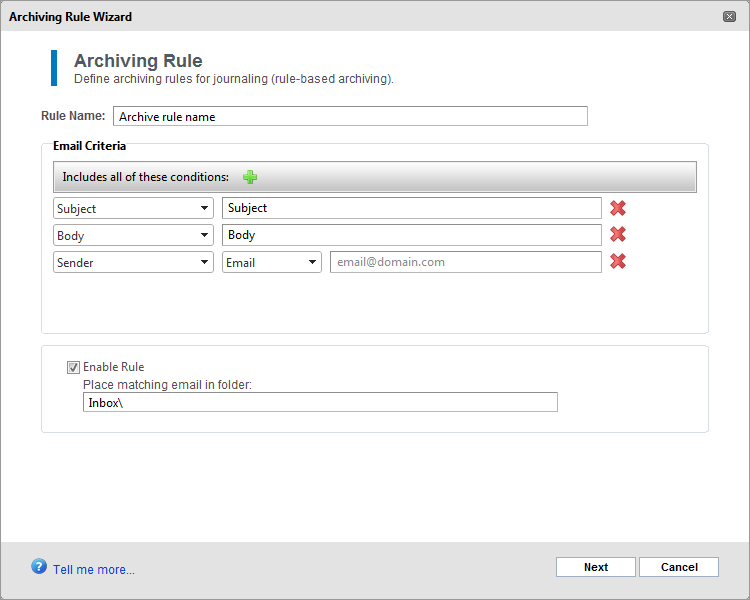Adding Archiving Rules
To add an Archiving Rule:
1. From Configuration tab, click Archiving Rules.
2. Click Add.

Adding a new Archiving Rule
3. In the Rule Name field, specify a meaningful name for the archiving rule.
4. In the Email Criteria section, specify rule conditions from the available options described in the table below. Click ![]() to add more conditions.
to add more conditions.
| Condition | Description |
|---|---|
| Subject | Emails that match the specified subject are archived. |
| Body | Emails that are an exact match to the a word or a sentence specified in this criteria are archived. |
| Sender |
Select Email and type the email address or select User and type the name of the user. NOTE A list of ADActive Directory users will be displayed when you start typing the first letters of an email address or a user name. |
| Recipient |
Select Email and type the email address or select User and type the name of the user. NOTE A list of AD users will be displayed when you start typing the first letters of an email address or a user name. |
| Full email size | Select a filter from the available options (Equals, Greater Than, Greater or Equal Than, Smaller Than, Smaller or Equal Than) and specify an email size in MB. |
| Attachment Size | Select a filter from the available options (Equals, Greater Than, Greater or Equal Than, Smaller Than, Smaller or Equal Than) and specify an attachment size in MB. |
| Attachment Type | Select a filter from the available options: Images, Documents, Music, Videos, Custom. |
NOTE
Wildcards are supported for both Sender and Recipient fields. For example, if you enter '*@domain.com', the value will match all users of 'domain.com'.
5. In the Place matching email in folder field, specify to which folder the email is archived.
NOTE
Using special characters in folder names
The folder path can be overwritten with the desired folder path using the following conventions:
\ (back slash) is represented by /\
/ (forward slash) is represented by //
For example:
To input a folder path for the following folder structure:

Input the following path: Inbox\Managerial//CEO\Requests/\Queries
NOTE
If the folder specified by the user does not exist, it is created automatically.
6. Click Next.
7. Click Finish.